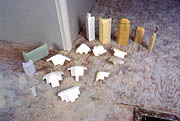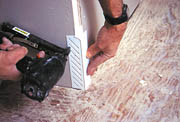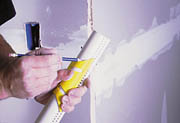

For starters, I looked up the word “accessory” in Webster’s dictionary. The definition was, “An object or device not essential in itself but adding to the beauty, convenience or effectiveness of something else.”
USG’s Handbook (1992) reads: “Trim accessories simplify and enhance the finishing of gypsum board assemblies. The accessories are low cost, easily applied, and designed to work together for long-lasting trouble-free construction. All are suitable for steel- and wood-frame construction.”
The only drywall accessories listed in this USG Handbook were metal square-angle outside corners, flexible metal corner tape, J-trim, L-trim and a control joint. In addition, there was a crude version of a flexible cornerbead.
After reading this, I decided it was time to order the updated version of USG’s Handbook.

Bull market
Several years ago, if I went into a drywall supply store and ordered 10 pieces of 90-degree cornerbead, there were no questions asked. I would end up walking out with 10 8-foot pieces of square-edged metal cornerbead. Today, I would have a choice of 90-degree square-edged metal, vinyl, paper-covered metal and paper-covered plastic. There are even some brands available in stick form while others come in rolls. Currently, we have 3/8-, 3/4- and 11⁄2-inch bullnose beads, each of which is available as an archway bead, and an L or J bead. There are beads available for off angles, both inside and outside, both straight and bullnosed. There are even beads that can have a fiber optic installed.Drywall accessories are being used more and more to decorate and beautify drywall. They are not only functional, they are also an important part of the decorating process.
I live in upstate New York and I think the Northeast is the last part of the country to use anything new. I have been using bullnose cornerbead for only six or seven years now. The first time I ever finished a 3/4-inch bullnose cornerbead, I thought that it was the most beautiful corner I had ever seen. It was easy to finish and didn’t cost much. It was a good way to make a few extra bucks on every job, while giving the end result a little extra style.
It wasn’t long before I convinced a general contractor to spend a few extra dollars per corner on a nice little house I was hanging and taping. He wanted all the outside corners bullnosed, which included the kitchen and bathroom soffits and all wrapped doorways. Once I started getting into it, I wondered how I was going to fit this stuff around the three-way outside corners on the kitchen soffit, not to mention the complaints I was bound to get from the finish carpenter as he tried to fit baseboard around the rounded corners. Maybe this stuff was not so beautiful after all.
What were needed for all these drywall accessories were more accessories. Accessories for the accessories seemed to be the answer.
The area most in need of these extra accessories was along the baseboard. Recently, I was at a very expensive home that was done entirely with 3/4-inch bullnose on the outside corners and I was surprised to see that the baseboard was just mitered square and the gap along the rounded corner was just caulked and painted. It looked OK. However, some customers would not be happy with the idea of caulk.
A simple and inexpensive way to remedy the situation is to use a bull adapter. The bull adapter is a special piece that looks like a regular square cornerbead. It is almost 6 inches long and can be trimmed or lifted off the floor to accommodate different height base. It joins to the bullnose outside corners and forms a square bottom corner. I’ve used the Trim-Tex bull adapter for both the 3/4-inch and 11⁄2-inch bullnose. This is a simple solution that allows me to use my beautiful bullnose beads and keep the trim guy happy at the same time. Another accessory option made by Trim-Tex is an actual vinyl piece of baseboard made to fit the radius. It matches standard and modern baseboard that is going to be painted.
Flannery Inc. makes a bullnose base corner plug. After the baseboard is installed, the corner plug is simply slid into the gap. This technique is much better and more professional than that sloppy caulk.
Trim-Tex has a variety of wood bullnose corner blocks that fit 3/4-inch bullnose and regular square corners, both inside and out. When installed in or on the corners, depending on the block chosen, up to a 51⁄4-inch-high baseboard can be accommodated. The baseboard is simply cut off square, no mitering required.
Flannery Inc. also offers wooden corner blocks. I have not used this service, but the company claims that if you send it a 6-inch sample of your base, it will try to match the configuration.
I was reading a drywall supply pamphlet the other day about a bullnose crimper. This tool reshapes a metal 3/4-inch bullnose cornerbead to a square corner for the baseboard. This tool retails for $425 and it’s selling, which proves how much people want to make installation and finishing as easy as possible for everyone.

Three-way challenge
All right, so the baseboard problem seems to be pretty well covered.The second biggest problem for me was the 3-way outside corner. I can do a pretty good job with regular square cornerbead. I fit the first bead in square, miter the lapping edge of the second bead and finish by mitering both edges of the final piece. Try this with a bullnose bead the next time you have a lot of time to waste or just buy the 3-way corner. Once again, Trim-Tex comes through with 3-ways for the 3/8, 3/4- and 11⁄2-inch bullnose bead. The company even has a 3-way for a splayed outside corner for the 3/8- and 3/4-inch styles. For those using bullnose for inside corners, there is a 3-way inside for the 3/4- and 11⁄2-inch bullnose.
Flannery Inc. makes a 3-way corner cap for the 3/4-inch bullnose, but only for the regular 90-degree corners.
The two companies I’ve mentioned so far make vinyl bead, but I know that whenever I go into some local drywall suppliers or a store like Home Depot, I’ll see some metal bullnose cornerbead. One company, Clinch-on Cornerbead Co., makes 3-way outsides for both 3/4- and 11⁄2-inch metal beads. The company even makes a 2-way outside corner for the metal beads.
Cornerbeading doorways and windows is easy if I use the 2-way corner to adjoin the beads at a 90-degree angle or a 135-degree angle, or I can use the bullnose miter marker (Trim-Tex) to create perfect inside corners. Either way, these inside corners will look great from the top corner to the baseboard.
I recently tried my hands at layering drywall. I layered 6-inch-wide strips on the upper wall along a hallway ceiling that also sloped down the stairway. The inside corners were easy; I just mitered them. Although I could have used a J round inside corner piece, what really came in handy was the J round outside corner.
As I mentioned before, the need to make things simple for the cornerbead installer, as well as the finish carpenter, has lead to production of the accessories for the accessories. Trim-Tex and Flannery Inc. have really addressed this situation for all the vinyl drywall accessories. Clinch-on has addressed metal accessories and USG has addressed paper-faced metal. I just received my new version of USG’s handbook and I read that its paper-faced metal bead has a 90-degree inside corner piece and a base adapter for the bullnose beads.
Other cornerbead manufactures that advertise in this magazine offering accessories are Phillips Manufacturing and Plastic Components Inc.
Some companies just make the corners and leave the accessories to the others. Keep in mind that one company’s accessories may not fit another company’s bead. Make sure everything will fit properly before planning to mix products.


